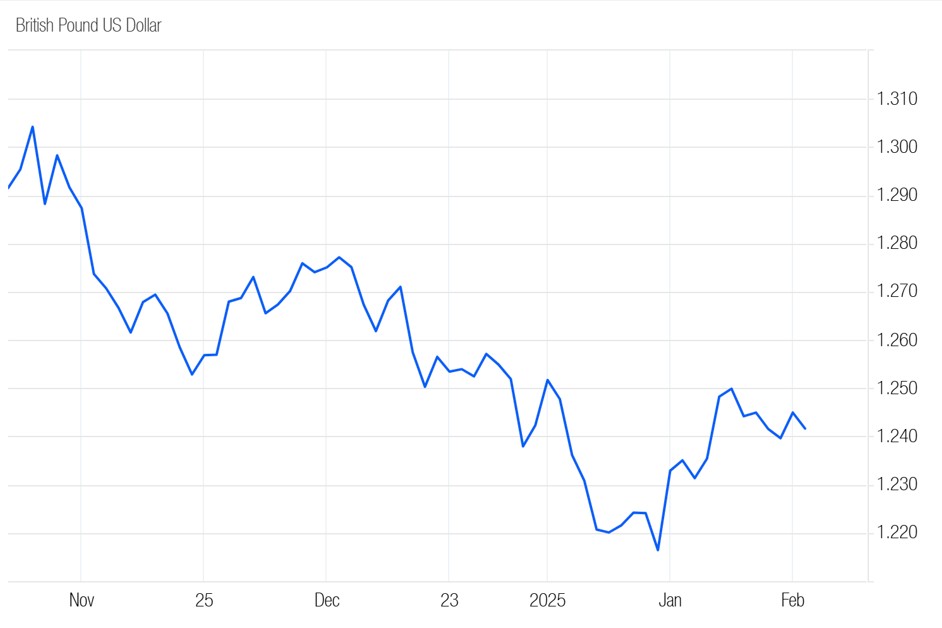GBP/USD exchange rate recovers from multi-month low in January
The pound dollar exchange rate climbed into the $1.25 range on 6 January after the US currency tumbled on Trump tariff optimism amid speculation of a more selective approach than his campaign rhetoric suggested.
The dollar rebounded the following day after US services PMI beat forecasts showed a stronger-than-expected expansion in activity in December, causing the pound to retreat below the $1.25 benchmark.
Downward pressure on the pound intensified on 8 January amid fresh Trump tariff fears that supported the dollar. Reports circulated that the President-elect was considering declaring a national economic emergency to rush through his proposed tariffs on US imports.
The pound extended its downside on 9 January amid concerns over rising UK government borrowing costs. By the following day, it had dropped to a 14-month low a fraction below the $1.22 level following the release of a strong US jobs report for December that beat forecasts.
The pound touched a fresh multi-month low versus the dollar on 13 January as UK borrowing costs climbed again and markets trimmed Federal Reserve interest rate cut bets. The UK currency clawed back most of its losses as bond yields started to ease.
The pound briefly spiked above the $1.23 benchmark on 15 January following a surprise slowdown in UK inflation in December. Meanwhile, core US CPI data, which showed inflation increased by the most in nine months in December, closed the door on a January rate cut from the Fed, supporting the dollar.
The pound dollar rate meandered between the $1.21 and $1.22 levels until 20 January, when the US currency was rocked by Donald Trump’s inauguration as President. The impact of the big day lifted the pair above $1.23 amid reports he would delay implementing tariffs on his first day back in the White House.
The pound jumped to within a whisker of the $1.25 benchmark on 24 January following the release of manufacturing and services PMIs from both sides. Tepid growth across the British business landscape edged up in January, but employment and optimism continued to contract, and price pressures increased. Meanwhile, US business activity slowed to a ninth-month low in January as price pressures rose, but hiring accelerated, supporting the Fed’s cautious approach to policy easing this year.
The pound dollar rate drifted lower in the final week of the month amid UK growth hopes, US growth worries, fading US tariff concerns and the Fed’s latest interest decision.
Fed policymakers voted to hold US interest rates steady on 29 January, and Chair Jerome Powell said there would be no rush to lower them again until inflation and jobs figures made it appropriate.
The dollar faced headwinds on 30 January as the US GDP print for the fourth quarter of 2024 showed a steeper-than-expected deceleration in economic growth. The US pared its losses after Donald Trump announced he would go ahead with implementing 25% tariffs on imports from Canada and Mexico on 1 February.
The pound dollar exchange rate ended the month at around $1.239.
GBPUSD: 3-Month Chart

Looking ahead
The BoE is limbering up to make a 25-basis point cut on 6 February, which will have a limited impact on the pound if it’s priced into the market.
Influential data from the UK economy in February: GDP (13 February), ILO Unemployment Rate (18 February), Consumer Price Index (19 February), Retail Sales (21 February), S&P Global/CIPS Composite PMI (25 February).
With no Fed monetary policy meeting in the diary this month, investors in the dollar will be focusing on key data that could influence future rate decisions, including nonfarm payrolls and the consumer price index.
Influential data from the US economy in February: ISM Manufacturing PMI (3 February), ADP Employment Change (5 February), ISM Services PMI (5 February), Nonfarm Payrolls (7 February), Consumer Price Index (12 February), Producer Price Index ex Food & Energy (13 February), Retail Sales (14 February), S&P Global Composite PMI (24 February) GDP (27 February), Core Personal Consumption Expenditures – Price Index (28 February).






